Nursing Assignment: Metronidazole Treatment for Malignant Wounds
VerifiedAdded on 2021/04/17
|9
|2142
|283
Report
AI Summary
This nursing assignment report focuses on the application of the ACE Star Model of Knowledge Transformation to evaluate evidence-based practice in malignant wound (MW) management. The report highlights the devastating effects of MW, including exudates, pain, and malodor, and explores the use of metronidazole as a potential treatment. It defines the scope of the practice issue, identifies stakeholders (nurses, doctors, therapists, etc.), and outlines team member responsibilities. The report summarizes evidence from systematic reviews and clinical trials, recommending the use of 0.75% gel metronidazole and silver dressings to reduce malodor and manage bleeding/exudates. It details a translation action plan, including desired outcomes (decreased malodor), measurement methods, and dissemination strategies. The report concludes with a discussion of the findings, emphasizing the importance of a multidisciplinary approach and nursing education in palliative care. References support the evidence-based recommendations.
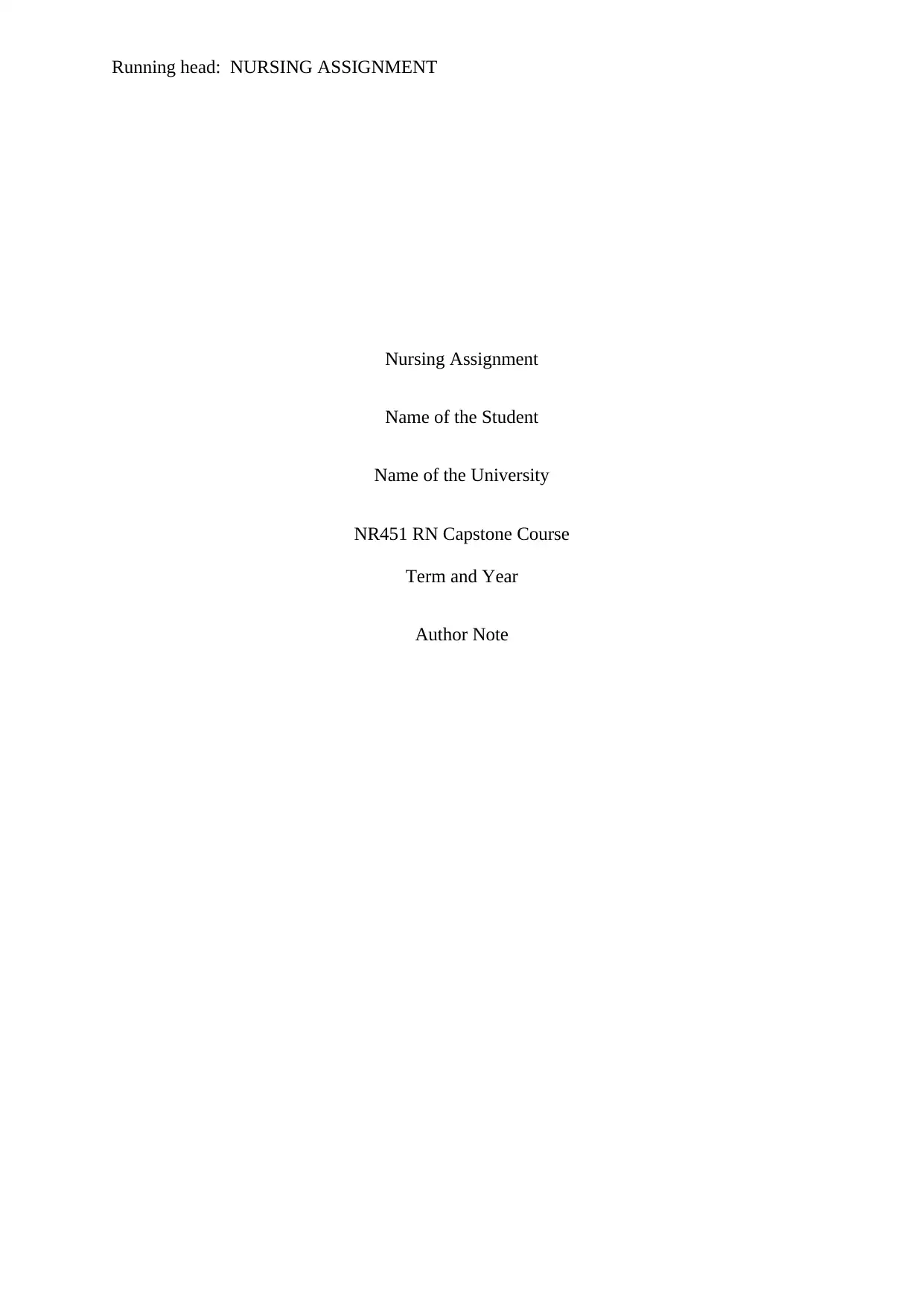
Running head: NURSING ASSIGNMENT
Nursing Assignment
Name of the Student
Name of the University
NR451 RN Capstone Course
Term and Year
Author Note
Nursing Assignment
Name of the Student
Name of the University
NR451 RN Capstone Course
Term and Year
Author Note
Paraphrase This Document
Need a fresh take? Get an instant paraphrase of this document with our AI Paraphraser
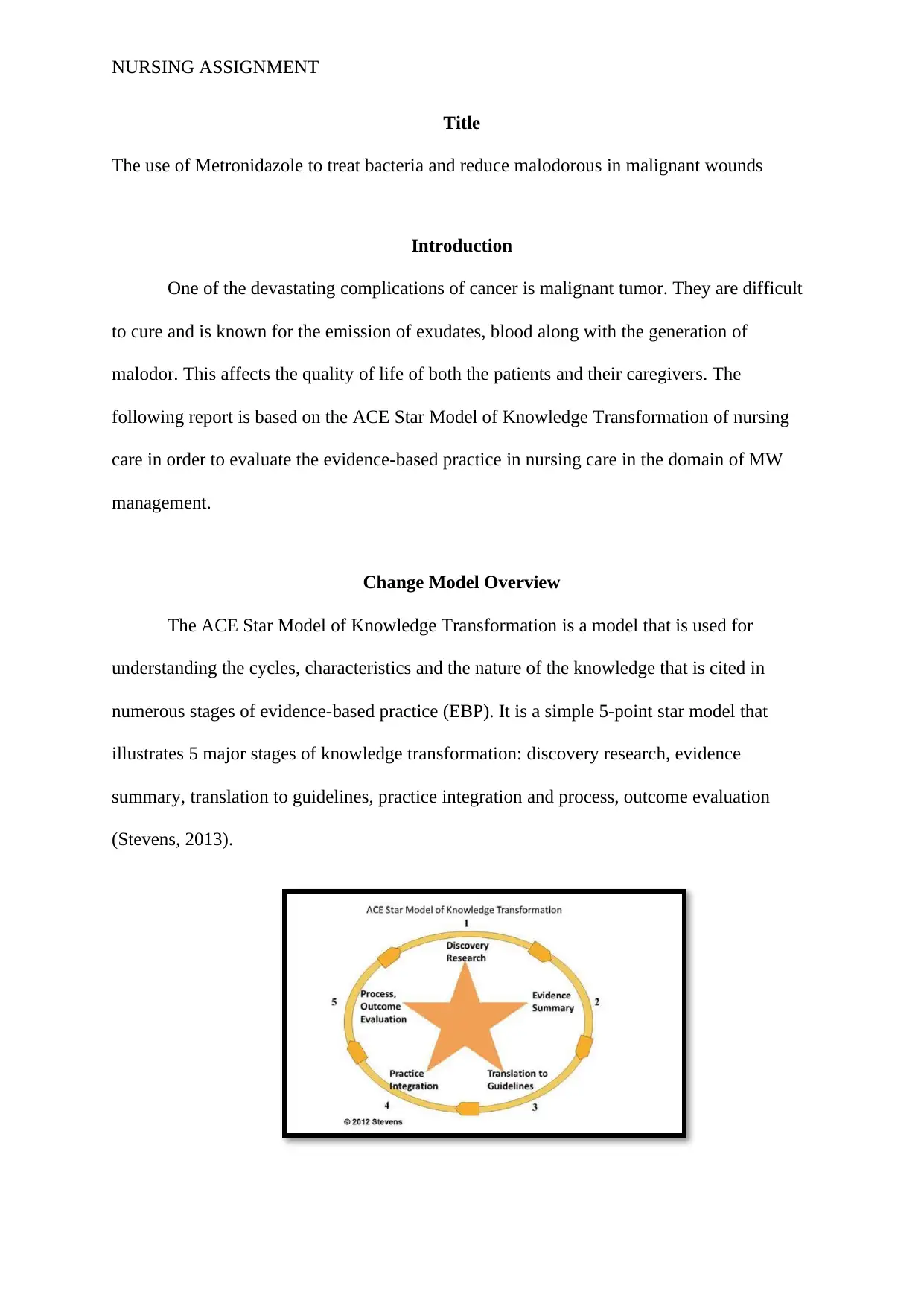
NURSING ASSIGNMENT
Title
The use of Metronidazole to treat bacteria and reduce malodorous in malignant wounds
Introduction
One of the devastating complications of cancer is malignant tumor. They are difficult
to cure and is known for the emission of exudates, blood along with the generation of
malodor. This affects the quality of life of both the patients and their caregivers. The
following report is based on the ACE Star Model of Knowledge Transformation of nursing
care in order to evaluate the evidence-based practice in nursing care in the domain of MW
management.
Change Model Overview
The ACE Star Model of Knowledge Transformation is a model that is used for
understanding the cycles, characteristics and the nature of the knowledge that is cited in
numerous stages of evidence-based practice (EBP). It is a simple 5-point star model that
illustrates 5 major stages of knowledge transformation: discovery research, evidence
summary, translation to guidelines, practice integration and process, outcome evaluation
(Stevens, 2013).
Title
The use of Metronidazole to treat bacteria and reduce malodorous in malignant wounds
Introduction
One of the devastating complications of cancer is malignant tumor. They are difficult
to cure and is known for the emission of exudates, blood along with the generation of
malodor. This affects the quality of life of both the patients and their caregivers. The
following report is based on the ACE Star Model of Knowledge Transformation of nursing
care in order to evaluate the evidence-based practice in nursing care in the domain of MW
management.
Change Model Overview
The ACE Star Model of Knowledge Transformation is a model that is used for
understanding the cycles, characteristics and the nature of the knowledge that is cited in
numerous stages of evidence-based practice (EBP). It is a simple 5-point star model that
illustrates 5 major stages of knowledge transformation: discovery research, evidence
summary, translation to guidelines, practice integration and process, outcome evaluation
(Stevens, 2013).
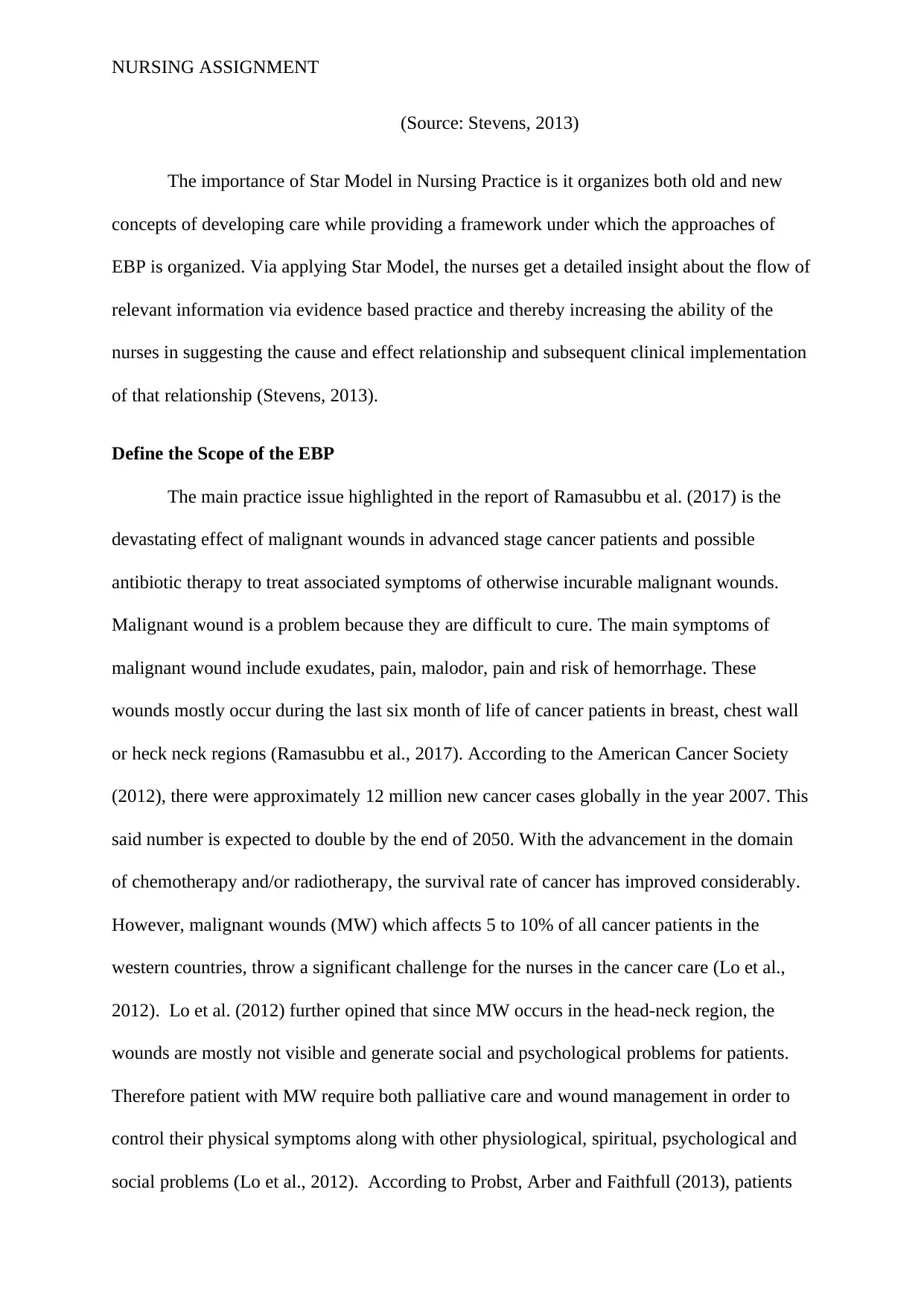
NURSING ASSIGNMENT
(Source: Stevens, 2013)
The importance of Star Model in Nursing Practice is it organizes both old and new
concepts of developing care while providing a framework under which the approaches of
EBP is organized. Via applying Star Model, the nurses get a detailed insight about the flow of
relevant information via evidence based practice and thereby increasing the ability of the
nurses in suggesting the cause and effect relationship and subsequent clinical implementation
of that relationship (Stevens, 2013).
Define the Scope of the EBP
The main practice issue highlighted in the report of Ramasubbu et al. (2017) is the
devastating effect of malignant wounds in advanced stage cancer patients and possible
antibiotic therapy to treat associated symptoms of otherwise incurable malignant wounds.
Malignant wound is a problem because they are difficult to cure. The main symptoms of
malignant wound include exudates, pain, malodor, pain and risk of hemorrhage. These
wounds mostly occur during the last six month of life of cancer patients in breast, chest wall
or heck neck regions (Ramasubbu et al., 2017). According to the American Cancer Society
(2012), there were approximately 12 million new cancer cases globally in the year 2007. This
said number is expected to double by the end of 2050. With the advancement in the domain
of chemotherapy and/or radiotherapy, the survival rate of cancer has improved considerably.
However, malignant wounds (MW) which affects 5 to 10% of all cancer patients in the
western countries, throw a significant challenge for the nurses in the cancer care (Lo et al.,
2012). Lo et al. (2012) further opined that since MW occurs in the head-neck region, the
wounds are mostly not visible and generate social and psychological problems for patients.
Therefore patient with MW require both palliative care and wound management in order to
control their physical symptoms along with other physiological, spiritual, psychological and
social problems (Lo et al., 2012). According to Probst, Arber and Faithfull (2013), patients
(Source: Stevens, 2013)
The importance of Star Model in Nursing Practice is it organizes both old and new
concepts of developing care while providing a framework under which the approaches of
EBP is organized. Via applying Star Model, the nurses get a detailed insight about the flow of
relevant information via evidence based practice and thereby increasing the ability of the
nurses in suggesting the cause and effect relationship and subsequent clinical implementation
of that relationship (Stevens, 2013).
Define the Scope of the EBP
The main practice issue highlighted in the report of Ramasubbu et al. (2017) is the
devastating effect of malignant wounds in advanced stage cancer patients and possible
antibiotic therapy to treat associated symptoms of otherwise incurable malignant wounds.
Malignant wound is a problem because they are difficult to cure. The main symptoms of
malignant wound include exudates, pain, malodor, pain and risk of hemorrhage. These
wounds mostly occur during the last six month of life of cancer patients in breast, chest wall
or heck neck regions (Ramasubbu et al., 2017). According to the American Cancer Society
(2012), there were approximately 12 million new cancer cases globally in the year 2007. This
said number is expected to double by the end of 2050. With the advancement in the domain
of chemotherapy and/or radiotherapy, the survival rate of cancer has improved considerably.
However, malignant wounds (MW) which affects 5 to 10% of all cancer patients in the
western countries, throw a significant challenge for the nurses in the cancer care (Lo et al.,
2012). Lo et al. (2012) further opined that since MW occurs in the head-neck region, the
wounds are mostly not visible and generate social and psychological problems for patients.
Therefore patient with MW require both palliative care and wound management in order to
control their physical symptoms along with other physiological, spiritual, psychological and
social problems (Lo et al., 2012). According to Probst, Arber and Faithfull (2013), patients
⊘ This is a preview!⊘
Do you want full access?
Subscribe today to unlock all pages.

Trusted by 1+ million students worldwide
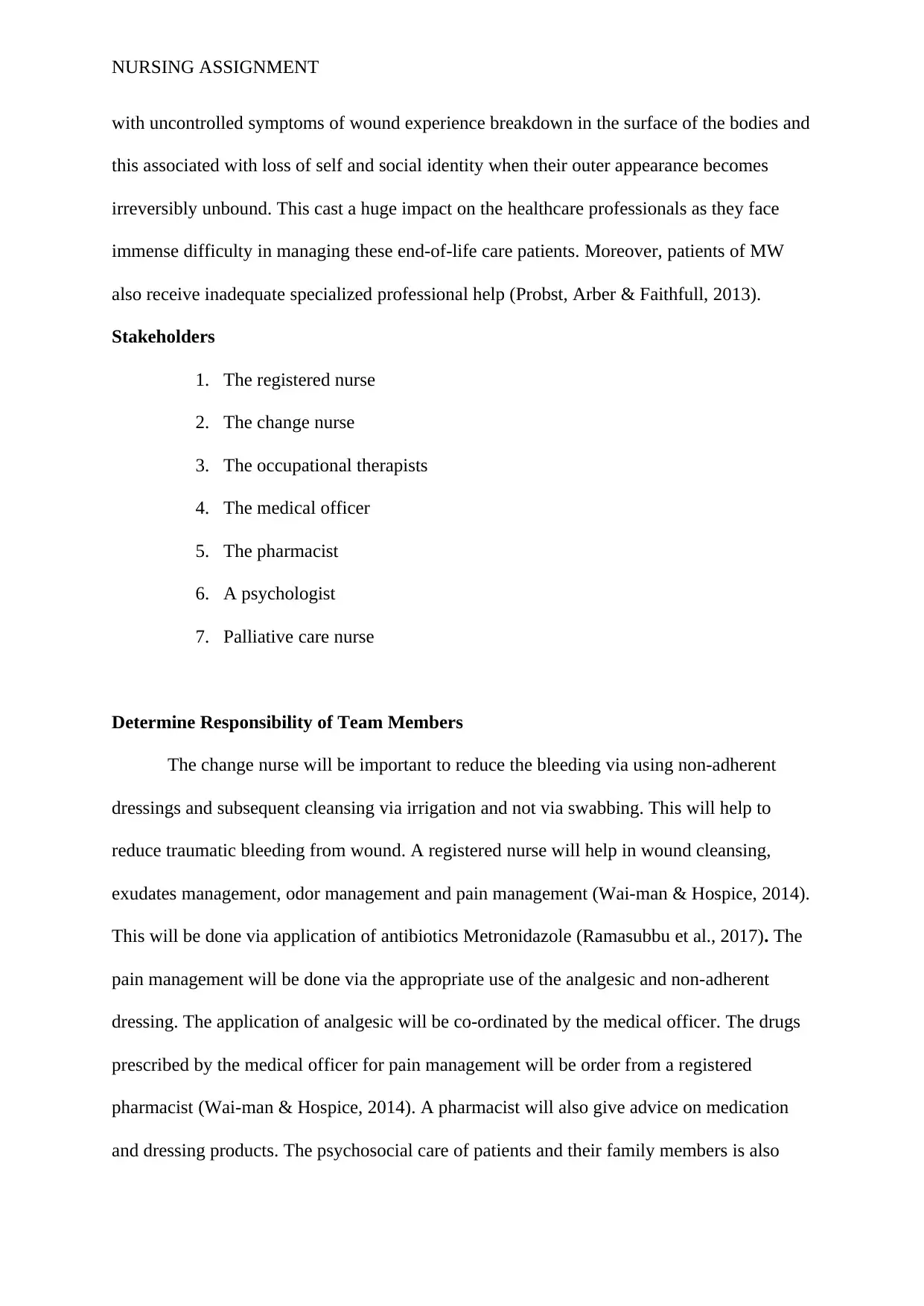
NURSING ASSIGNMENT
with uncontrolled symptoms of wound experience breakdown in the surface of the bodies and
this associated with loss of self and social identity when their outer appearance becomes
irreversibly unbound. This cast a huge impact on the healthcare professionals as they face
immense difficulty in managing these end-of-life care patients. Moreover, patients of MW
also receive inadequate specialized professional help (Probst, Arber & Faithfull, 2013).
Stakeholders
1. The registered nurse
2. The change nurse
3. The occupational therapists
4. The medical officer
5. The pharmacist
6. A psychologist
7. Palliative care nurse
Determine Responsibility of Team Members
The change nurse will be important to reduce the bleeding via using non-adherent
dressings and subsequent cleansing via irrigation and not via swabbing. This will help to
reduce traumatic bleeding from wound. A registered nurse will help in wound cleansing,
exudates management, odor management and pain management (Wai-man & Hospice, 2014).
This will be done via application of antibiotics Metronidazole (Ramasubbu et al., 2017). The
pain management will be done via the appropriate use of the analgesic and non-adherent
dressing. The application of analgesic will be co-ordinated by the medical officer. The drugs
prescribed by the medical officer for pain management will be order from a registered
pharmacist (Wai-man & Hospice, 2014). A pharmacist will also give advice on medication
and dressing products. The psychosocial care of patients and their family members is also
with uncontrolled symptoms of wound experience breakdown in the surface of the bodies and
this associated with loss of self and social identity when their outer appearance becomes
irreversibly unbound. This cast a huge impact on the healthcare professionals as they face
immense difficulty in managing these end-of-life care patients. Moreover, patients of MW
also receive inadequate specialized professional help (Probst, Arber & Faithfull, 2013).
Stakeholders
1. The registered nurse
2. The change nurse
3. The occupational therapists
4. The medical officer
5. The pharmacist
6. A psychologist
7. Palliative care nurse
Determine Responsibility of Team Members
The change nurse will be important to reduce the bleeding via using non-adherent
dressings and subsequent cleansing via irrigation and not via swabbing. This will help to
reduce traumatic bleeding from wound. A registered nurse will help in wound cleansing,
exudates management, odor management and pain management (Wai-man & Hospice, 2014).
This will be done via application of antibiotics Metronidazole (Ramasubbu et al., 2017). The
pain management will be done via the appropriate use of the analgesic and non-adherent
dressing. The application of analgesic will be co-ordinated by the medical officer. The drugs
prescribed by the medical officer for pain management will be order from a registered
pharmacist (Wai-man & Hospice, 2014). A pharmacist will also give advice on medication
and dressing products. The psychosocial care of patients and their family members is also
Paraphrase This Document
Need a fresh take? Get an instant paraphrase of this document with our AI Paraphraser
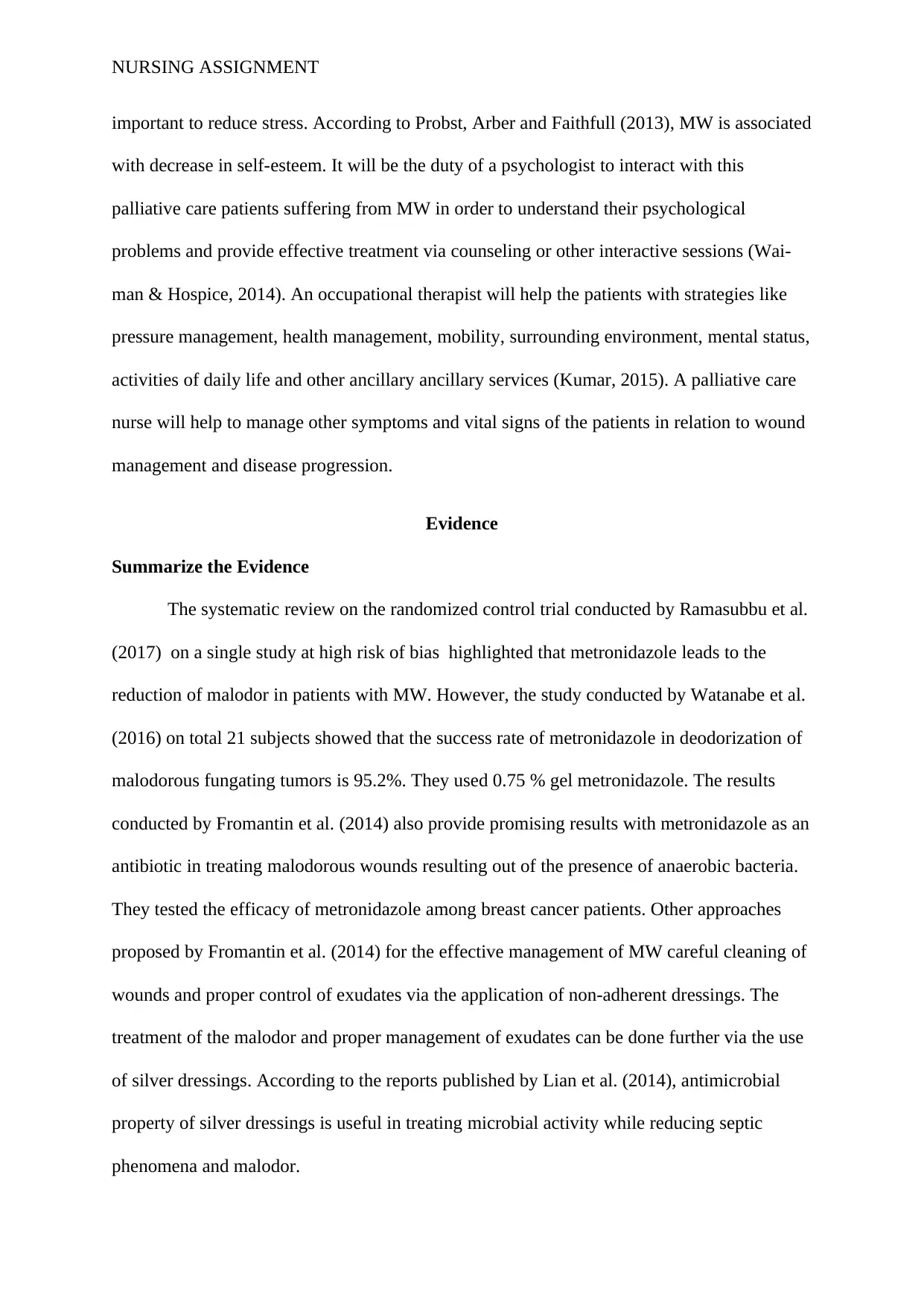
NURSING ASSIGNMENT
important to reduce stress. According to Probst, Arber and Faithfull (2013), MW is associated
with decrease in self-esteem. It will be the duty of a psychologist to interact with this
palliative care patients suffering from MW in order to understand their psychological
problems and provide effective treatment via counseling or other interactive sessions (Wai-
man & Hospice, 2014). An occupational therapist will help the patients with strategies like
pressure management, health management, mobility, surrounding environment, mental status,
activities of daily life and other ancillary ancillary services (Kumar, 2015). A palliative care
nurse will help to manage other symptoms and vital signs of the patients in relation to wound
management and disease progression.
Evidence
Summarize the Evidence
The systematic review on the randomized control trial conducted by Ramasubbu et al.
(2017) on a single study at high risk of bias highlighted that metronidazole leads to the
reduction of malodor in patients with MW. However, the study conducted by Watanabe et al.
(2016) on total 21 subjects showed that the success rate of metronidazole in deodorization of
malodorous fungating tumors is 95.2%. They used 0.75 % gel metronidazole. The results
conducted by Fromantin et al. (2014) also provide promising results with metronidazole as an
antibiotic in treating malodorous wounds resulting out of the presence of anaerobic bacteria.
They tested the efficacy of metronidazole among breast cancer patients. Other approaches
proposed by Fromantin et al. (2014) for the effective management of MW careful cleaning of
wounds and proper control of exudates via the application of non-adherent dressings. The
treatment of the malodor and proper management of exudates can be done further via the use
of silver dressings. According to the reports published by Lian et al. (2014), antimicrobial
property of silver dressings is useful in treating microbial activity while reducing septic
phenomena and malodor.
important to reduce stress. According to Probst, Arber and Faithfull (2013), MW is associated
with decrease in self-esteem. It will be the duty of a psychologist to interact with this
palliative care patients suffering from MW in order to understand their psychological
problems and provide effective treatment via counseling or other interactive sessions (Wai-
man & Hospice, 2014). An occupational therapist will help the patients with strategies like
pressure management, health management, mobility, surrounding environment, mental status,
activities of daily life and other ancillary ancillary services (Kumar, 2015). A palliative care
nurse will help to manage other symptoms and vital signs of the patients in relation to wound
management and disease progression.
Evidence
Summarize the Evidence
The systematic review on the randomized control trial conducted by Ramasubbu et al.
(2017) on a single study at high risk of bias highlighted that metronidazole leads to the
reduction of malodor in patients with MW. However, the study conducted by Watanabe et al.
(2016) on total 21 subjects showed that the success rate of metronidazole in deodorization of
malodorous fungating tumors is 95.2%. They used 0.75 % gel metronidazole. The results
conducted by Fromantin et al. (2014) also provide promising results with metronidazole as an
antibiotic in treating malodorous wounds resulting out of the presence of anaerobic bacteria.
They tested the efficacy of metronidazole among breast cancer patients. Other approaches
proposed by Fromantin et al. (2014) for the effective management of MW careful cleaning of
wounds and proper control of exudates via the application of non-adherent dressings. The
treatment of the malodor and proper management of exudates can be done further via the use
of silver dressings. According to the reports published by Lian et al. (2014), antimicrobial
property of silver dressings is useful in treating microbial activity while reducing septic
phenomena and malodor.
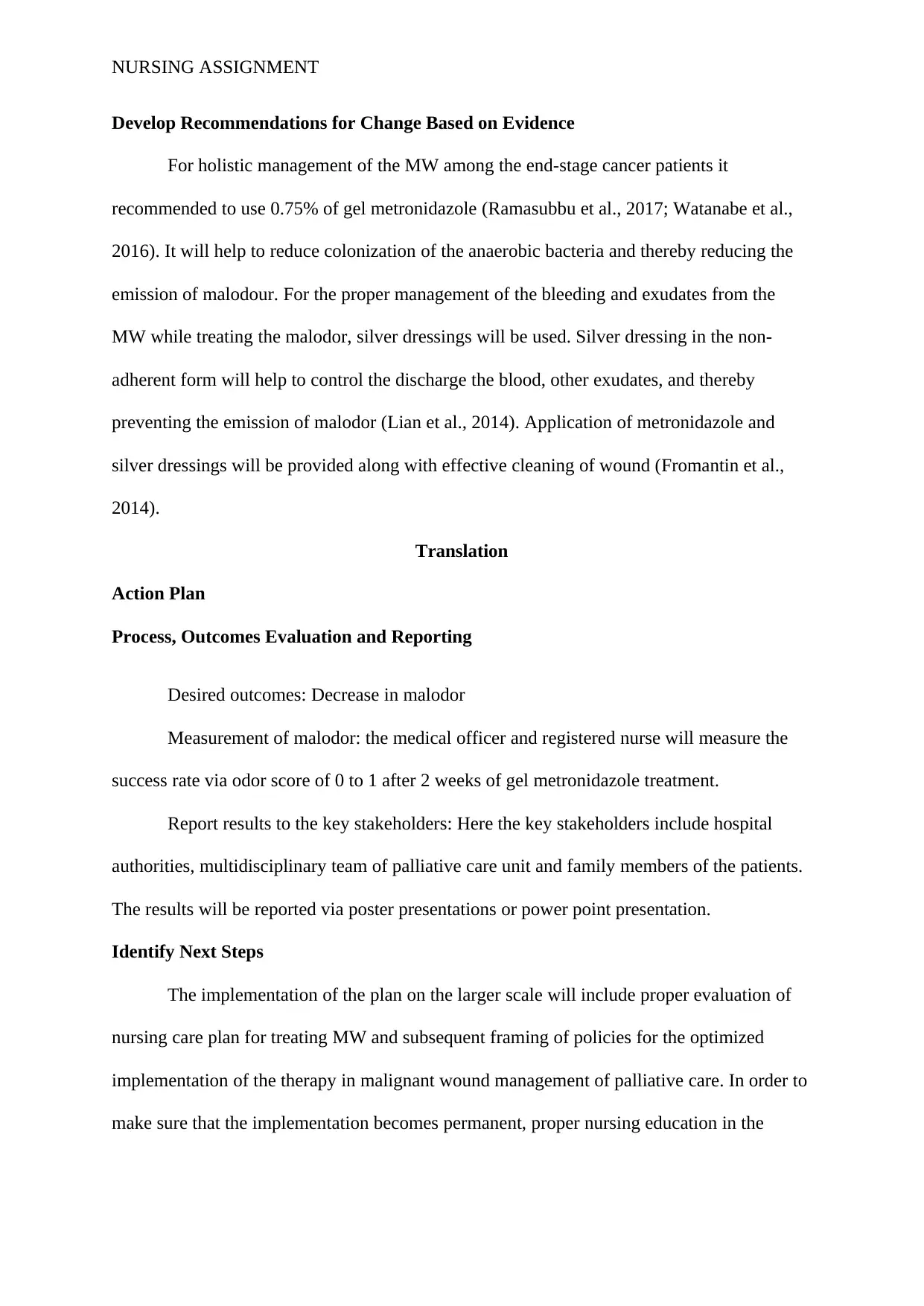
NURSING ASSIGNMENT
Develop Recommendations for Change Based on Evidence
For holistic management of the MW among the end-stage cancer patients it
recommended to use 0.75% of gel metronidazole (Ramasubbu et al., 2017; Watanabe et al.,
2016). It will help to reduce colonization of the anaerobic bacteria and thereby reducing the
emission of malodour. For the proper management of the bleeding and exudates from the
MW while treating the malodor, silver dressings will be used. Silver dressing in the non-
adherent form will help to control the discharge the blood, other exudates, and thereby
preventing the emission of malodor (Lian et al., 2014). Application of metronidazole and
silver dressings will be provided along with effective cleaning of wound (Fromantin et al.,
2014).
Translation
Action Plan
Process, Outcomes Evaluation and Reporting
Desired outcomes: Decrease in malodor
Measurement of malodor: the medical officer and registered nurse will measure the
success rate via odor score of 0 to 1 after 2 weeks of gel metronidazole treatment.
Report results to the key stakeholders: Here the key stakeholders include hospital
authorities, multidisciplinary team of palliative care unit and family members of the patients.
The results will be reported via poster presentations or power point presentation.
Identify Next Steps
The implementation of the plan on the larger scale will include proper evaluation of
nursing care plan for treating MW and subsequent framing of policies for the optimized
implementation of the therapy in malignant wound management of palliative care. In order to
make sure that the implementation becomes permanent, proper nursing education in the
Develop Recommendations for Change Based on Evidence
For holistic management of the MW among the end-stage cancer patients it
recommended to use 0.75% of gel metronidazole (Ramasubbu et al., 2017; Watanabe et al.,
2016). It will help to reduce colonization of the anaerobic bacteria and thereby reducing the
emission of malodour. For the proper management of the bleeding and exudates from the
MW while treating the malodor, silver dressings will be used. Silver dressing in the non-
adherent form will help to control the discharge the blood, other exudates, and thereby
preventing the emission of malodor (Lian et al., 2014). Application of metronidazole and
silver dressings will be provided along with effective cleaning of wound (Fromantin et al.,
2014).
Translation
Action Plan
Process, Outcomes Evaluation and Reporting
Desired outcomes: Decrease in malodor
Measurement of malodor: the medical officer and registered nurse will measure the
success rate via odor score of 0 to 1 after 2 weeks of gel metronidazole treatment.
Report results to the key stakeholders: Here the key stakeholders include hospital
authorities, multidisciplinary team of palliative care unit and family members of the patients.
The results will be reported via poster presentations or power point presentation.
Identify Next Steps
The implementation of the plan on the larger scale will include proper evaluation of
nursing care plan for treating MW and subsequent framing of policies for the optimized
implementation of the therapy in malignant wound management of palliative care. In order to
make sure that the implementation becomes permanent, proper nursing education in the
⊘ This is a preview!⊘
Do you want full access?
Subscribe today to unlock all pages.

Trusted by 1+ million students worldwide
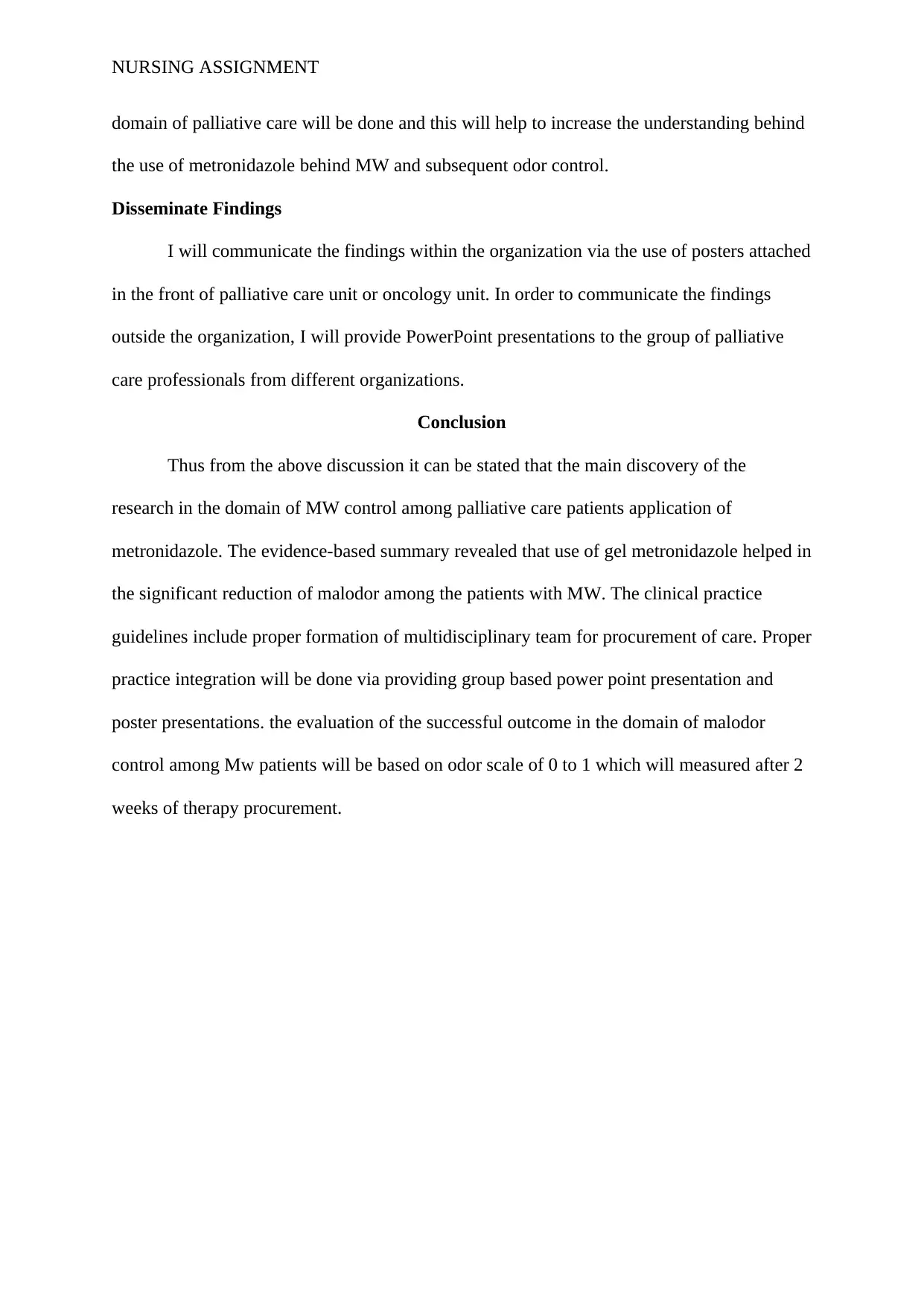
NURSING ASSIGNMENT
domain of palliative care will be done and this will help to increase the understanding behind
the use of metronidazole behind MW and subsequent odor control.
Disseminate Findings
I will communicate the findings within the organization via the use of posters attached
in the front of palliative care unit or oncology unit. In order to communicate the findings
outside the organization, I will provide PowerPoint presentations to the group of palliative
care professionals from different organizations.
Conclusion
Thus from the above discussion it can be stated that the main discovery of the
research in the domain of MW control among palliative care patients application of
metronidazole. The evidence-based summary revealed that use of gel metronidazole helped in
the significant reduction of malodor among the patients with MW. The clinical practice
guidelines include proper formation of multidisciplinary team for procurement of care. Proper
practice integration will be done via providing group based power point presentation and
poster presentations. the evaluation of the successful outcome in the domain of malodor
control among Mw patients will be based on odor scale of 0 to 1 which will measured after 2
weeks of therapy procurement.
domain of palliative care will be done and this will help to increase the understanding behind
the use of metronidazole behind MW and subsequent odor control.
Disseminate Findings
I will communicate the findings within the organization via the use of posters attached
in the front of palliative care unit or oncology unit. In order to communicate the findings
outside the organization, I will provide PowerPoint presentations to the group of palliative
care professionals from different organizations.
Conclusion
Thus from the above discussion it can be stated that the main discovery of the
research in the domain of MW control among palliative care patients application of
metronidazole. The evidence-based summary revealed that use of gel metronidazole helped in
the significant reduction of malodor among the patients with MW. The clinical practice
guidelines include proper formation of multidisciplinary team for procurement of care. Proper
practice integration will be done via providing group based power point presentation and
poster presentations. the evaluation of the successful outcome in the domain of malodor
control among Mw patients will be based on odor scale of 0 to 1 which will measured after 2
weeks of therapy procurement.
Paraphrase This Document
Need a fresh take? Get an instant paraphrase of this document with our AI Paraphraser
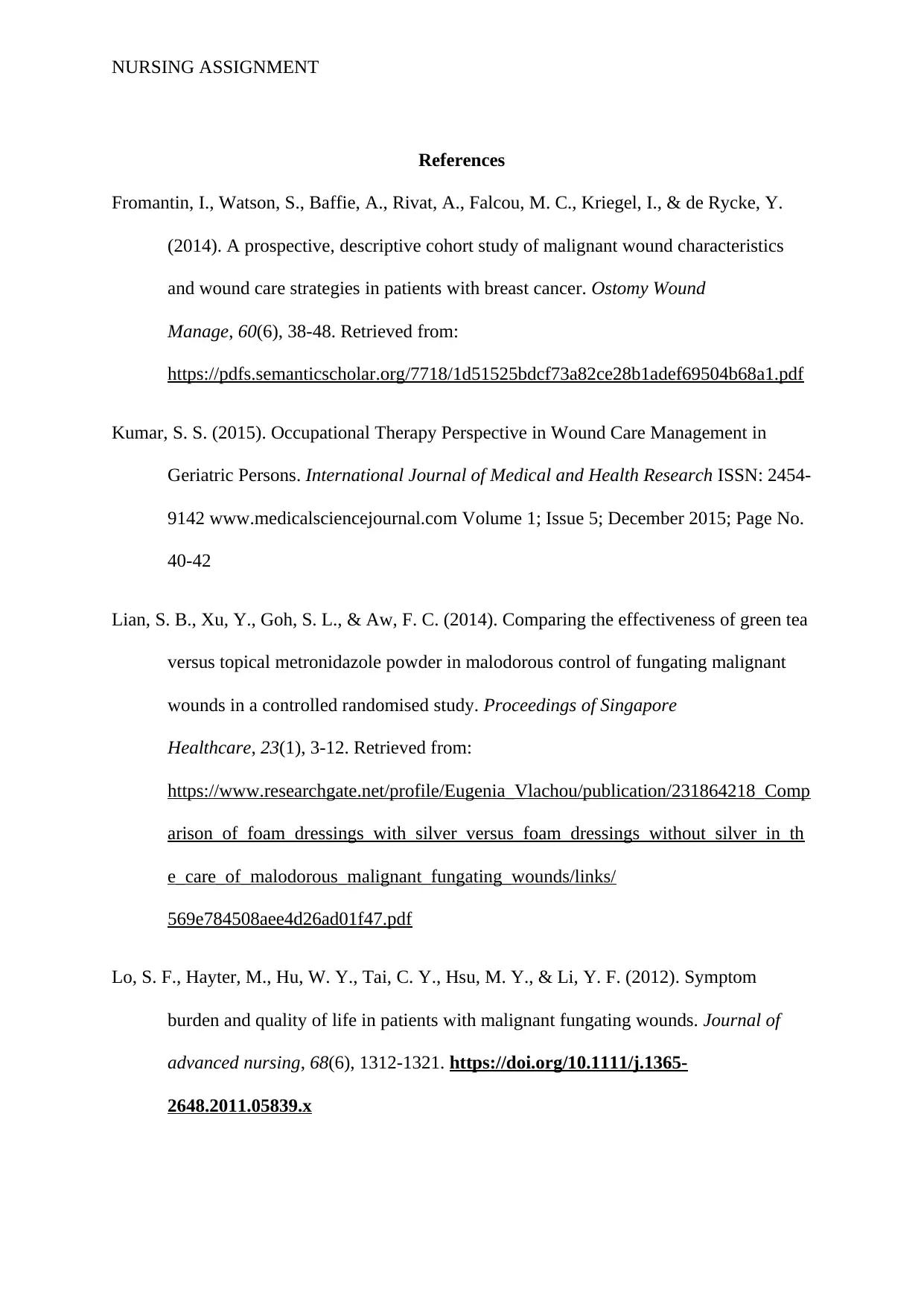
NURSING ASSIGNMENT
References
Fromantin, I., Watson, S., Baffie, A., Rivat, A., Falcou, M. C., Kriegel, I., & de Rycke, Y.
(2014). A prospective, descriptive cohort study of malignant wound characteristics
and wound care strategies in patients with breast cancer. Ostomy Wound
Manage, 60(6), 38-48. Retrieved from:
https://pdfs.semanticscholar.org/7718/1d51525bdcf73a82ce28b1adef69504b68a1.pdf
Kumar, S. S. (2015). Occupational Therapy Perspective in Wound Care Management in
Geriatric Persons. International Journal of Medical and Health Research ISSN: 2454-
9142 www.medicalsciencejournal.com Volume 1; Issue 5; December 2015; Page No.
40-42
Lian, S. B., Xu, Y., Goh, S. L., & Aw, F. C. (2014). Comparing the effectiveness of green tea
versus topical metronidazole powder in malodorous control of fungating malignant
wounds in a controlled randomised study. Proceedings of Singapore
Healthcare, 23(1), 3-12. Retrieved from:
https://www.researchgate.net/profile/Eugenia_Vlachou/publication/231864218_Comp
arison_of_foam_dressings_with_silver_versus_foam_dressings_without_silver_in_th
e_care_of_malodorous_malignant_fungating_wounds/links/
569e784508aee4d26ad01f47.pdf
Lo, S. F., Hayter, M., Hu, W. Y., Tai, C. Y., Hsu, M. Y., & Li, Y. F. (2012). Symptom
burden and quality of life in patients with malignant fungating wounds. Journal of
advanced nursing, 68(6), 1312-1321. https://doi.org/10.1111/j.1365-
2648.2011.05839.x
References
Fromantin, I., Watson, S., Baffie, A., Rivat, A., Falcou, M. C., Kriegel, I., & de Rycke, Y.
(2014). A prospective, descriptive cohort study of malignant wound characteristics
and wound care strategies in patients with breast cancer. Ostomy Wound
Manage, 60(6), 38-48. Retrieved from:
https://pdfs.semanticscholar.org/7718/1d51525bdcf73a82ce28b1adef69504b68a1.pdf
Kumar, S. S. (2015). Occupational Therapy Perspective in Wound Care Management in
Geriatric Persons. International Journal of Medical and Health Research ISSN: 2454-
9142 www.medicalsciencejournal.com Volume 1; Issue 5; December 2015; Page No.
40-42
Lian, S. B., Xu, Y., Goh, S. L., & Aw, F. C. (2014). Comparing the effectiveness of green tea
versus topical metronidazole powder in malodorous control of fungating malignant
wounds in a controlled randomised study. Proceedings of Singapore
Healthcare, 23(1), 3-12. Retrieved from:
https://www.researchgate.net/profile/Eugenia_Vlachou/publication/231864218_Comp
arison_of_foam_dressings_with_silver_versus_foam_dressings_without_silver_in_th
e_care_of_malodorous_malignant_fungating_wounds/links/
569e784508aee4d26ad01f47.pdf
Lo, S. F., Hayter, M., Hu, W. Y., Tai, C. Y., Hsu, M. Y., & Li, Y. F. (2012). Symptom
burden and quality of life in patients with malignant fungating wounds. Journal of
advanced nursing, 68(6), 1312-1321. https://doi.org/10.1111/j.1365-
2648.2011.05839.x
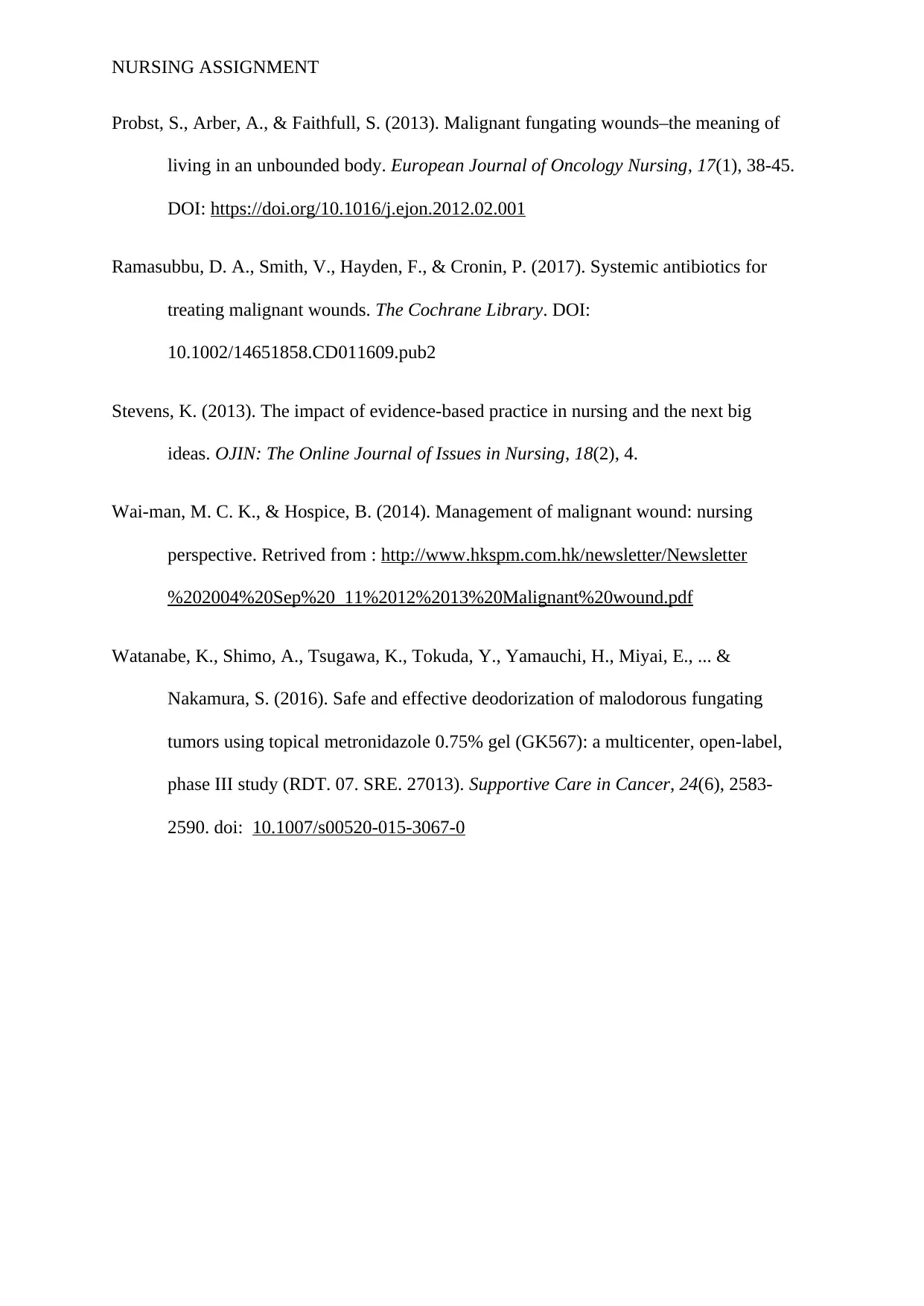
NURSING ASSIGNMENT
Probst, S., Arber, A., & Faithfull, S. (2013). Malignant fungating wounds–the meaning of
living in an unbounded body. European Journal of Oncology Nursing, 17(1), 38-45.
DOI: https://doi.org/10.1016/j.ejon.2012.02.001
Ramasubbu, D. A., Smith, V., Hayden, F., & Cronin, P. (2017). Systemic antibiotics for
treating malignant wounds. The Cochrane Library. DOI:
10.1002/14651858.CD011609.pub2
Stevens, K. (2013). The impact of evidence-based practice in nursing and the next big
ideas. OJIN: The Online Journal of Issues in Nursing, 18(2), 4.
Wai-man, M. C. K., & Hospice, B. (2014). Management of malignant wound: nursing
perspective. Retrived from : http://www.hkspm.com.hk/newsletter/Newsletter
%202004%20Sep%20_11%2012%2013%20Malignant%20wound.pdf
Watanabe, K., Shimo, A., Tsugawa, K., Tokuda, Y., Yamauchi, H., Miyai, E., ... &
Nakamura, S. (2016). Safe and effective deodorization of malodorous fungating
tumors using topical metronidazole 0.75% gel (GK567): a multicenter, open-label,
phase III study (RDT. 07. SRE. 27013). Supportive Care in Cancer, 24(6), 2583-
2590. doi: 10.1007/s00520-015-3067-0
Probst, S., Arber, A., & Faithfull, S. (2013). Malignant fungating wounds–the meaning of
living in an unbounded body. European Journal of Oncology Nursing, 17(1), 38-45.
DOI: https://doi.org/10.1016/j.ejon.2012.02.001
Ramasubbu, D. A., Smith, V., Hayden, F., & Cronin, P. (2017). Systemic antibiotics for
treating malignant wounds. The Cochrane Library. DOI:
10.1002/14651858.CD011609.pub2
Stevens, K. (2013). The impact of evidence-based practice in nursing and the next big
ideas. OJIN: The Online Journal of Issues in Nursing, 18(2), 4.
Wai-man, M. C. K., & Hospice, B. (2014). Management of malignant wound: nursing
perspective. Retrived from : http://www.hkspm.com.hk/newsletter/Newsletter
%202004%20Sep%20_11%2012%2013%20Malignant%20wound.pdf
Watanabe, K., Shimo, A., Tsugawa, K., Tokuda, Y., Yamauchi, H., Miyai, E., ... &
Nakamura, S. (2016). Safe and effective deodorization of malodorous fungating
tumors using topical metronidazole 0.75% gel (GK567): a multicenter, open-label,
phase III study (RDT. 07. SRE. 27013). Supportive Care in Cancer, 24(6), 2583-
2590. doi: 10.1007/s00520-015-3067-0
⊘ This is a preview!⊘
Do you want full access?
Subscribe today to unlock all pages.

Trusted by 1+ million students worldwide
1 out of 9
Your All-in-One AI-Powered Toolkit for Academic Success.
+13062052269
info@desklib.com
Available 24*7 on WhatsApp / Email
![[object Object]](/_next/static/media/star-bottom.7253800d.svg)
Unlock your academic potential
Copyright © 2020–2025 A2Z Services. All Rights Reserved. Developed and managed by ZUCOL.

